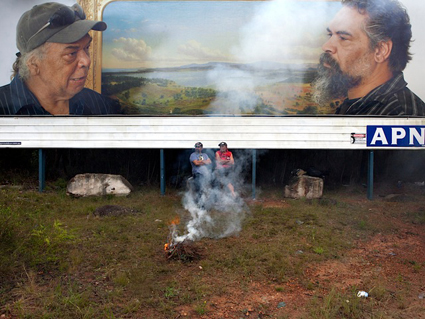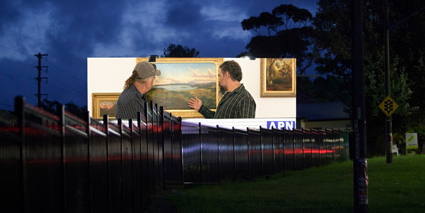just another moment in time…and then some
ella mudie: derek kreckler, appropriated circumstances

Roy takes a break after showing Kelton the best fishing spots (detail) with Roy Kennedy and Kelton Pell sitting at APN billboard site, Waterfall, NSW; Appropriated Circumstances, 2012
photo, Derek Kreckler 2012
Roy takes a break after showing Kelton the best fishing spots (detail) with Roy Kennedy and Kelton Pell sitting at APN billboard site, Waterfall, NSW; Appropriated Circumstances, 2012
MORE THAN ANY OTHER TYPE OF IMAGE, THE ROADSIDE BILLBOARD OPERATES IN THE REALM OF OUR PERIPHERAL VISION AS THE SIGN GLIMPSED OVER AND OVER THROUGH THE CORNER OF AN EYE.
For this reason, artists who venture toward the billboard as a vehicle for art typically take a forthright approach, figures such as Barbara Kruger and her contemporary successors—culture jammers who employ the graphically bold and arresting strategies of advertising, turning it against itself. In these instances, ultimately the subversion resides more in the message than in the mode of visual communication.
An oblique approach is rarer. Yet this is precisely what was encountered in artist Derek Kreckler’s two roadside billboard installations from his Appropriated Circumstances series that intrigued drivers along the Princes Highway at Heathcote on the Sydney outbound route and at another inbound site just out of Waterfall from late February until April. Devoid of any text, slogan or signifier of a commercial entity or brand, Kreckler’s billboards were essentially large photographs in the landscape that, as drivers approached, registered like a glitch upon the sight line. Gentler than most advertising images with their naturalistic tones and clean, uncluttered white background, the billboards almost blended into the surrounding landscape and vegetation. “Because they’re highly detailed as photographs, it’s a different type of push on the viewer,” suggests Kreckler. “People look twice at them.”
Anti-advertising is one description that’s been suggested for the signs but it’s a term that perhaps doesn’t quite register the rich complexity of their visual rhetoric. The pair of billboards present two photographs taken by Kreckler that record a meeting between well-known Wollongong Dharawal activist and storyteller Roy ‘Dootch’ Kennedy and actor Kelton Pell, a Noongah man from South Western Australia, captured in front of a 19th century landscape painting in the City of Wollongong Gallery. The seemingly anachronistic gilt framed scene which is the object of their attention is colonial artist Eugene von Guérard’s View of Lake Illawarra with distant mountains of Kiama (1860). Its sweepingly picturesque and pristine view of the local topography pre-industrialisation presents a striking contrast to today’s developed coastline.
Titled “Dootch takes a break after showing Kelton the best fishing spots” and “Strewth” (a clue to one of the billboards’ precursors?) Kreckler’s self-funded installations have more in common with visual strategies such as new objectivist image-making than the methods of public art as they’re typically understood. Commenting on the impetus of the work, Kreckler identifies a number of antecedent threads including a long held fascination with the museum photographs of Thomas Struth (b1954) which capture crowds of spectators looking at iconic paintings in the Louvre, the Prado in Madrid and other famous museums. When Kreckler encountered von Guérard’s near photographic oil study in the Wollongong City Gallery, he began to consider the work in this context (incidentally, Kreckler points out that both Struth and von Guérard trained at the Düsseldorf Art Academy in Germany). It was a meeting with Dootch Kennedy, though, that eventually shifted Kreckler’s thinking into a more temporal terrain.
“To me, the von Guérard painting appears quite old, but to Dootch it’s just another moment in time,” says Kreckler. The artist suggested to Dootch the idea of photographing him in front of the work and once he’d agreed, Kreckler introduced him to Pell. When the two men met in the gallery the painting immediately became a catalyst for cultural exchange as Dootch spiritedly imparted his considerable knowledge of the plentiful food source sites around the lake (Lake Illawarra is also regarded as having been an important location for Indigenous ceremonial and traditional activities). Kreckler took a large number of photographs without a particular construction in mind, simply observing the moment and shooting until the camera became invisible. Afterwards, he gave some thought as to how to exhibit the images. “I was feeling that I didn’t just want to put a photograph in a gallery and photography is so ubiquitous these days. I wanted to honour the work in a different way.” It was only later, driving past a billboard at Waterfall which at the time was displaying the now infamous “Want Longer Lasting Sex” advertisements, that Kreckler was struck by the possibility of appropriating the boards.

Derek Kreckler, ‘Strewth’, from the series Appropriated Circumstance, 2012, Princes Highway, Heathcote NSW
courtesy the artist
Derek Kreckler, ‘Strewth’, from the series Appropriated Circumstance, 2012, Princes Highway, Heathcote NSW
A multidisciplinary artist embedded in conceptual modes of thinking and making, Kreckler’s photographic practice interrogates the conventions of seeing. With images that are coolly precise and quietly performative, the apparent everyday quality of the scenes typically belies the web of temporal and perceptual concerns that cook and simmer with prolonged looking. Driving around the gentle bend and over the crest of the road on the approach to the “Strewth” billboard at Heathcote, the immediate impression of encountering two large-scale figures looming over the traffic with their backs turned away from the stream of passing cars was almost disconcerting in its denial of the viewer’s gaze. But following the direction of their line of vision into the painting, guided by Pell’s gesturing toward the von Guérard with an outstretched hand, absorbs the viewer into the men’s shared act of observation. Momentarily, looking takes on a surprisingly participatory dimension. For the drivers who passed the billboards on their daily route along the Princes Highway the back story of the images’ construction would have been irrelevant—what the observant driver encountered was a puzzle, a cryptic story with a network of referents that yielded more clues with each repeat viewing, while refusing any revelation.
Paintings like von Guérard’s View of Lake Illawarra increasingly hold interest for their ‘time capsule’ effect and there’s an aptness in Kreckler’s appropriation of this work given the recent reappraisal of the artist’s oeuvre. Long dismissed as too European in his perceptions of the Australian landscape but now gaining a new appreciation for the sublime qualities and scientific motivations of his paintings, von Guérard’s unspoiled landscapes carry greater resonance in an age of environmental crisis. The fact that an artist can undergo such extremes of reception is a reminder that all perception is cultural and susceptible to destabilising twists and turns. Kreckler’s creative appropriation of the billboard likewise reveals the shifts that can occur when a conditioned habit of seeing, or not seeing, is disrupted and fixed relations are unmoored, imaginatively set adrift into unexpected reconfigurations.
Derek Kreckler, Appropriated Circumstances, billboard installations at Heathcote, Feb 27–March 25 and Waterfall, NSW, Feb 27 – Apr 22
RealTime issue #109 June-July 2012 pg. 45






